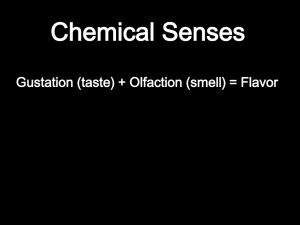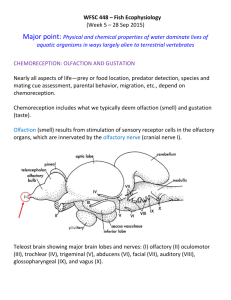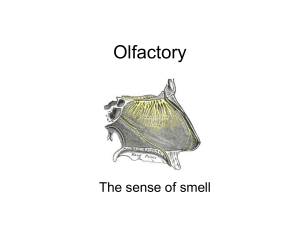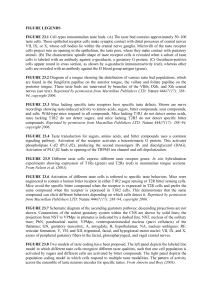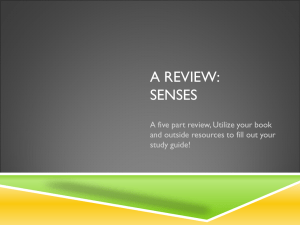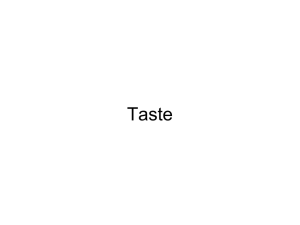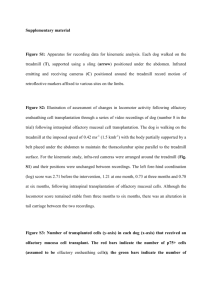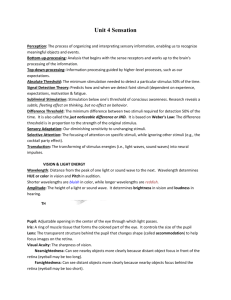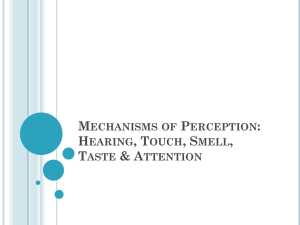Olfactory Gustatory Only Outline
advertisement
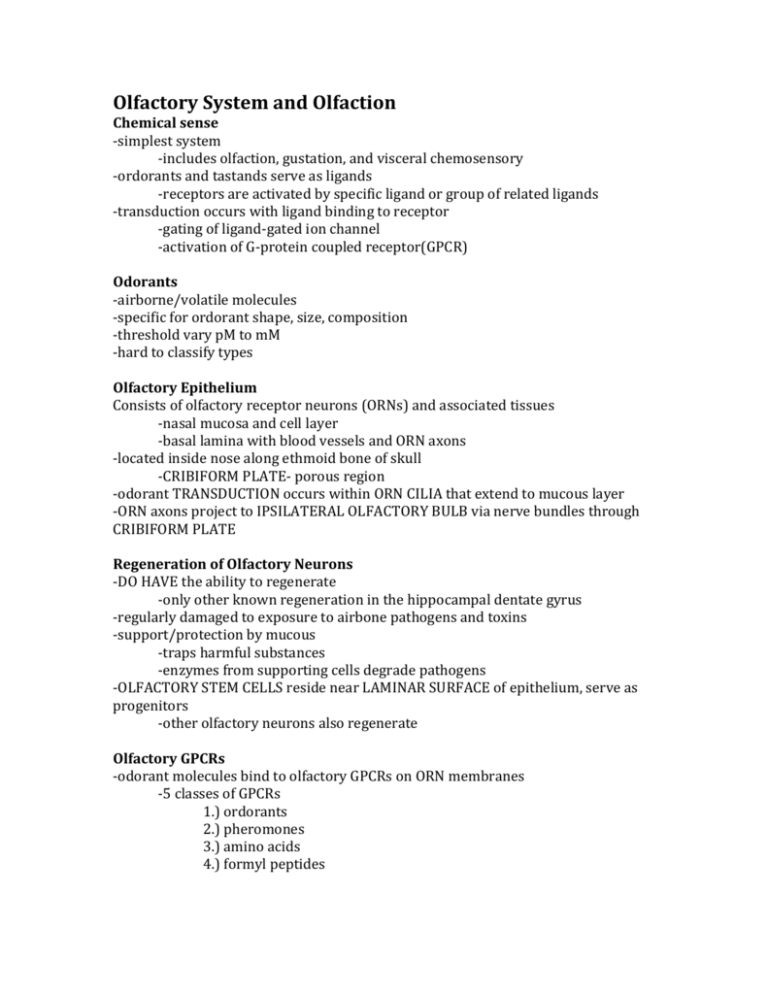
Olfactory System and Olfaction Chemical sense -simplest system -includes olfaction, gustation, and visceral chemosensory -ordorants and tastands serve as ligands -receptors are activated by specific ligand or group of related ligands -transduction occurs with ligand binding to receptor -gating of ligand-gated ion channel -activation of G-protein coupled receptor(GPCR) Odorants -airborne/volatile molecules -specific for ordorant shape, size, composition -threshold vary pM to mM -hard to classify types Olfactory Epithelium Consists of olfactory receptor neurons (ORNs) and associated tissues -nasal mucosa and cell layer -basal lamina with blood vessels and ORN axons -located inside nose along ethmoid bone of skull -CRIBIFORM PLATE- porous region -odorant TRANSDUCTION occurs within ORN CILIA that extend to mucous layer -ORN axons project to IPSILATERAL OLFACTORY BULB via nerve bundles through CRIBIFORM PLATE Regeneration of Olfactory Neurons -DO HAVE the ability to regenerate -only other known regeneration in the hippocampal dentate gyrus -regularly damaged to exposure to airbone pathogens and toxins -support/protection by mucous -traps harmful substances -enzymes from supporting cells degrade pathogens -OLFACTORY STEM CELLS reside near LAMINAR SURFACE of epithelium, serve as progenitors -other olfactory neurons also regenerate Olfactory GPCRs -odorant molecules bind to olfactory GPCRs on ORN membranes -5 classes of GPCRs 1.) ordorants 2.) pheromones 3.) amino acids 4.) formyl peptides Olfactory Transduction 1.) ordorants bind to GPCR in membrane of ORN cilia 2.) activates odorant-specific G protein 3.) activite G olf alpha subunit activates adenyl cyclase III 4.) adenyl cyclase III converts ATP cAMP 5.) cAMP activates cyclic nucleotide-gated (CNG) cation channel -produce influx Na+ and Ca+ -additional depol from Cl- efflux 6.) depol Na+ and Ca+ influx produce AP in ORN, transmitted via olfactory bulb Adaptation to ordorants -receptor response declines with sustained ordorant exposure -Ca+ influx through CNG cation channel activates intracellular Ca+-binding protein calmodulin (CaM) -CaM closes CNG cation channel -CaM kinase II turns off adenyl cyclase II -phosphodiesterase 1 C converts cAMP AMP -phosphorylation inactivates odorant GPCR Olfactory receptor selectivity -ORNs exhibit single type of ordorant GPCR -GPCRs can respond to single or multiple odorants -depend on molecular structure of odorant and region of binding -different GPCRs have different affinities for the same odorant molecule explains how perception of odorant can change with odorant concentration Structure of Olfactory Bulb -obligatory synapse for ascending ORN axons -laminar structure located on ventral surface of forebrain -MITRAL CELL dendrites receive synaptic input from ORNs in GLOMERULI -mitral cell axons project to OLFACTORY CORTEX -tufted cells reside between mitral cells and glomeruli -periglomerular cells receive synaptic input in glomeruli and project to mitral and tufted cell dendrites -granule cells receive synaptic input from projection cell axons and feedback to projection cell dendrites Olfactory bulb glomeruli -specialized synaptic structure in olfactory bulb -each glomerulus consists of dendrites from mitral, tufted, and periglomerular cells -receives synaptic input from thousands of ORNs expressing same odor receptor Other olfactory bulb features -reciprocal dendrodendritic synapses -both sets of dendrites release NT and exhibit postsynaptic response -may serve to sharpen odor “tuning” within and across glomeruli -neural regeneration -not limited to epithelial ORNs -includes periglomerular and granule cells Central olfactory pathways -sensory cortical target is in uncus on ventral forebrain -part of specialized paleocortex -3-4 layers -inputs in layer 1, not 4 -projection neurons layer 2, not 5 -output projects to multiple portions of the limbic system -includes: entorhinal cortex, amygdala, thalamus -memory and emotion -speech and vision Olfaction, memory, and emotion -olfactoy pathways in brain initiate memory and emotion response -territorial and reproductive cues in many mammals -stimulus for synchronized menstrual cycles for female roommates -can trigger memory association with odor -volatile substances in food activate olfactory receptors Olfactory pathology Anosmia or hyposmia – loss or reduction of smell -multiple causes: infection, mechanical blockage, excess mucus, head trauma, aging, medication -resolves when infection clears, when damages ORNs replaced during regeneration -can alter taste of food and result in appetite loss Olfactory hallucinations-perception of noxious odors not present -typically precedes seizures in uncus Gustatory System and Gustation Overview of gustatory system -characterizes chemical and physical properties of ingested substances -promote ingestion of nutrients, prevent ingestion of toxic compounds -prepare digestive tract to initiate digestive process -strong relationship between taste and appetite -pleasant taste =enhance appetite -unpleasant taste = diminish appetite -hunger can enhance taste perception -extremely unpleasant taste can initiate nausea and/or vomiting Organization of gustatory system -taste perception mediated by three cranial nerves 1.) facial (VII)-Chorda tympani branch 2.) glossopharengeal (IX) 3.) vagus (X) -ipsilateral projection to nucleus of solitary tract (NTS) in brainstem -reciprocal connections between NTS, hypothalamus, and amygdala -responsible for affective response to taste, modulation of taste -ipsilateral and contralateral projections to ventral posteromedial thalamus and gustatory cortices -connection to cortex only ipsilateral Classification of tastants 1.) Sweet -includes sugars, alcohols, ketones, and amino acids -sucrose threshold around 10 mM -everywhere 2.) Umami or savory -monosodiumglutamate (MSG) and amino acids -MSG threshold around 20 mM -everywhere 3.) Salty -inorganic salts such as NaCl, NaF, NH4Cl,MgCl2 -NaCl threshold around 10 mM -frontal, lateral 4.) Sour -acidic compounds that produce H+ -acid threshold around pH 4 -lateral sides of tongue 5.) Bitter -organic alkaloids, often highly toxic -quinine threashold around 10 mM -back of tongue -taste perceptions formed by combinations of these tastants and/or other somatosensory modalities -ex. Hot pepper, metallic, greasy Taste bud anatomy -PAPILLAE are structures that contain taste buds or nerve endings -taste receptors exposed to salivary fluids on or below tongue surface -various papillae types on tongue 1.) Circumvallate papillae (50%) -ringed structure encircles central body on posterior tongue -taste receptors project to glossopharyngeal nerve 2.) Fungiform papillae (25%) -mushroom shaped, anterior tongue -taste receptors project to facial nerve 3.) Foliate papillae (25%) -linear ridge structure along poserior tongue -taste receptors project to glossopharyngeal nerve 4.) Filliform –MOST NUMEROUS, NOT INVOLVED IN GUSTATION -conical shape, cilia projections throughout tongue -mechanosensitive nerve endings -transmit info to CNS via trigeminal -taste buds consist of taste and supporting cell -basal cells support taste cell -tastant receptors on microvilli extending into taste pore Tastant Transduction -2 classes of tastant transduction 1.) direct gating or permeation of ion channels -Salty: amiloride sensitive Na+ channel -Sour: H+ sensitive TRP channel, known as PKD2L1 2.) GPCR mediated responses in sweet, umami, and bitter -GPCR activates G-protein that activates PLC -PLC produces IP3 -IP3 gates TRPm Ca+ channels and Ca+ release from intracellular stores -Ca+ influxes leads to NT release Trigeminal chemoreception -consists of nocioreceptive afferents in trigeminal (V), glossopharyngeal (IX), and vagus (X) -provides info about ingesting irritant chemicals irritants include: 1.) NH3 2.) Ethanol 3.) Acetic acid 4.) CO2 5.) Methanol 6.) Capsaicin -relay to spinal trigeminal nucleus and ventral posteromedial thalamus -initiates reflexes including: 1.) salivation 2.) perspiration 3.) tearing and nasal secretion 4.) respiratory responses Gustatory pathology Ageusia- loss of taste -can result from various disorders -LESIONS IN FACIAL NERVE or GLOSSOPHARYNGEAL NERVE -facial nerve lesions often occur after middle ear disease or surgery -Chorda tympani passes through middle ear -head trauma -loss of taste buds during aging -LESIONS in UNCUS region of brain can lead to abnormal taste sensations -gustatory hallucinations may precede seizures with temporal lobe origins

